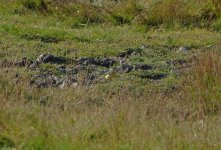Noel E has kindly sent me an account of more of his Camp ringing exploits. (That is, Weybourne !)
It appears that I had wrongly sexed (
not in the Shakespearean sense, I hasten to add) the ‘new’ bird at Gramboro’.
SHE (a 1st W female) succumbed to Noel’s juicy worms (as it were) and, now dazzlingly accoutred with Lime/Brown, Green/Metal, consorts with the much-reported male. He further describes “a more extensive area of white in the greater coverts than usual in a female” which, together with her dark appearance, had led me to wonder about her gender. They seem to be an ‘item’ and all is well with the world.
It is interesting being apprised of this, the continuing
Saxicola Saga.
On a related topic, shots of a gorgeous Caspian from the Netherlands are here:
http://waarneming.nl/soort/photos/1073?from=2012-10-06&to=2012-10-06
One like this would be most welcome here.
Gramboro’ this a.m. still held a couple of
Blue Tits and there was another close to the Beach car park. The most unusual record was a
Grey Wagtail down in the field- having possibly flown in from the east. A
Rock Pipit squeaked west.
More from the east (well, it is drawing closer to Christmas and then Epiphany) were my first properly migrating
Jays- and a magical, even eery, and silent sight they were, too. Small parties went west, past the concrete pad at the westernmost track at Warham Greens. They floated in from the east, occasionally hedge-hopping.
A quick jaunt north of there, to the ‘island off the coast’ was disappointing, as we’d already had the highlights, with the Jays. Notable were only a
Great Spotted Woodpecker,
2 Chiffchaffs and around a half-dozen
Wrens. Many of the brambles are quite depleted and it’s very dry out there.
Quick and prob stupid question to the Norfolk experts. If you could visit Norfolk for one week in oct or nov which week would it be?
You will note that we are only experts until we get things wrong; then we are castigated. The easterlies forecast for this weekend, for instance, have just not materialised. This has led to almost nothing happening, on the rare bird front, as Jim says:
Well, I cannot remember a quieter weekend, in October, in Norfolk!




